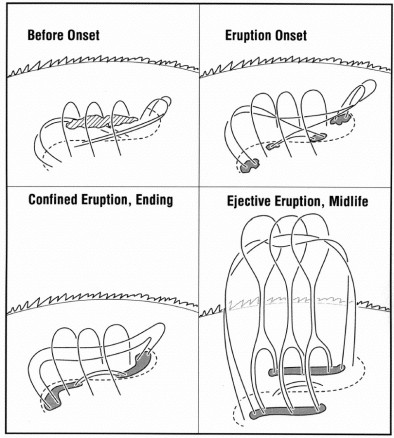RHESSI/SOHO/TRACE Workshop
Working Group 4 - Flares without CMEs
Observations over the past couple of decades have resulted in
a "standard model" for eruptive solar flares. According to
this model, highly sheared magnetic fields erupt outward from
the Sun and eventually become the CME, while the lower
portions of those fields reclose via magnetic reconnection to
generate flares. In this view the flare and CME go
hand-in-hand, co-existing with each other. So what happens
when there are flares without CMEs? How and where does this
"standard" picture break down? Working group 5 will
investigate this puzzle.
Questions
1. How common are flares without CMEs?
2. One idea holds that most or all flares fit the standard
model, but in the cases where no CME results something
prevents the erupting fields from completely escaping the
Sun. That is, such eruptions are "failures" because the
associated material is "confined" to the neighborhood of the
erupting region. Are most CME-less flare events such "failed
eruptions"?
3. In the case of failed eruptions, what prevents the
erupting fields from leaving the Sun? One possibility is the
presence of overlying magnetic fields which block the
erupting fields. Another possibility is that the erupting
fields themselves reach a new equilibrium before leaving the
Sun.
4. Are there special hard X-ray characteristics of flares
without CMEs? If overlying fields prevent the erupting
fields from escaping the Sun, a hard X-ray source might
appear where the erupting fields run into the blocking
fields.
5. Are there particular magnetic characteristics of the
regions producing failed eruptions in comparison to those that
produce "successful" eruptions? If overlying blocking fields
are required, perhaps confined eruptions cannot occur in
regions of simple magnetic geometry.
Observations
Our main data sets will be from TRACE, RHESSI, and SOHO, and
Yohkoh data will be useful for events occurring prior to
December 2001.
TRACE has seen several examples were filaments start to erupt,
but then get stopped prior to escaping. A starting point
could be to check a list of such TRACE events to see whether they
produced a CME in LASCO data. We expect not, but it would be
very interesting if some of these events which at-first-sight
appear to fail actually do produce CMEs! Matching the TRACE
data with RHESSI data will give clues about possible interactions
between the erupting fields and the overlying blocking fields.
Schematic Picture
Moore (2000) and Moore et al. (2001) give a schematic picture
of how the standard model can account for both eruptive and
confined flares:

[Caption from Moore et al. (2001).] Our version of the
standard model for the magnetic field explosion in
single-bipole eruptive solar events (from Moore 2000). This
version is tailored to bipoles having sigmoidally sheared and
twisted core fields and accommodates confined explosions as
well as ejective explosions. The rudiments of the field
configuration are shown before, during, and after the onset
of an explosion that is unleashed by internal tether-cutting
reconnection. The dashed curve is the photospheric neutral
line, the dividing line between the two opposite-polarity
domains of the bipole's magnetic roots. The ragged arc in the
background is the chromospheric limb. The gray areas are
bright patches or ribbons of flare emission in the
chromosphere at the feet of reconnected field lines, field
lines that we would expect to see illuminated in SXT images.
The diagonally lined feature above the neutral line in the
top left panel is the filament of chromospheric temperature
plasma that is often present in sheared core fields.
We will be able to test this picture of confined eruptions
using observational data. Or, perhaps create a new picture.
Events for study
TRACE event on 1999 October 20, near 6 UT.
Kay et al. (2003) list several candidate events.
We hope to put together a list of the best examples by the
time of the workshop. Suggestions welcome!
Literature
Relevant papers:
Kay et al. (2003).
"The soft X-ray characteristics of solar flares, both with and without associated CMEs."
Moore et al. (2000). "Solar Prominence Eruption," in Encyclopedia of Astronomy and
Astrophysics, ed. P. Murdin (Bristol: Instit. of Phys. Publishing), p. 2691.
Moore et al. (2001).
"Onset of the Magnetic Explosion in Solar Flares and Coronal Mass Ejections."
A. Sterling, S. Krucker

